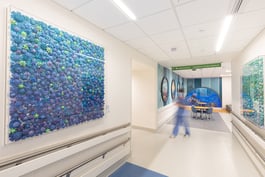Public art is more than an aesthetic addition: it’s a cornerstone of successful placemaking. For developers, municipalities, and planners, it is a strategic tool that shapes identity, strengthens social connection, and reflects the unique history, values, and people of a community. When thoughtfully integrated into a development plan, public art becomes a long-term investment in both cultural vitality and economic value. At TurningArt, we help developers and organizations navigate every step of this process, ensuring that art isn’t just an afterthought, but a defining feature that elevates a space and leaves a lasting impression.
The Value of Public Art for Developers and Communities
Community spaces are designed to bring people together, and the addition of art makes these environments more attuned to the human experience (CBRE, 2023). Public art can tell a community’s story, give visibility to underrepresented narratives, and spark dialogue that fosters empathy and connection. This cultural depth makes places not just functional, but memorable.
For developers, the benefits go beyond social impact. A thriving public art program can be a powerful economic driver, attracting tourism, supporting local businesses, and even enhancing property values (CBRE, 2023). Many cities recognize this return on investment through “percent-for-art” programs, allocating a portion of capital budgets to art (Americans for the Arts, 2018). Public art also reinforces community vitality: when people see themselves reflected in their environment, they develop a stronger sense of ownership and respect, which contributes to long-term loyalty and stability in the area.
Perhaps most importantly, for both community leaders and property owners, is how public art positively influences well-being. Research shows that exposure to art can reduce stress, inspire creative thinking, and improve cognitive function. A 2022 study by Rita Ochoa found that public art promotes psychological restoration, encourages walking and exploration, and strengthens emotional attachment to a place: all qualities that increase dwell time and engagement.
Emerging Trends in Public Art Planning
Public art is evolving to meet the expectations of today’s communities, which are more connected, technology-driven, and experience-focused. Interactive and multisensory installations, featuring light, sound, and digital technology, are on the rise, offering immersive experiences that make a development stand out (Ochoa, 2022).
Another major trend is embedding public art into urban planning from the earliest stages of a project. Developers are now incorporating art into the design of transit hubs, healthcare campuses, mixed-use developments, and parks to ensure it becomes part of the space’s core identity (Americans for the Arts, 2018).
Temporary and rotating installations are also gaining momentum. They keep spaces fresh, encourage repeat visits, and give developers flexibility to refresh programming over time (CBRE, 2023). Community-led projects, where residents collaborate in the creation of artwork, are equally important: they increase relevance, inclusivity, and a sense of ownership, making the development feel truly integrated into its surroundings.
Public Art as a Strategic Placemaking Asset
Beyond its cultural and social value, public art is a branding tool for developers and organizations. It strengthens a place's identity by aligning with community values, positioning the property as a meaningful destination. According to Americans for the Arts, integrating art early in the development process shapes how people remember and interact with a space. Art that reflects local stories fosters authenticity, encourages community loyalty, and enhances the user experience, much like how art in interior workplaces reduces stress, sparks creativity, and improves mood. When treated as part of a broader placemaking strategy, public art becomes a tangible asset with a measurable return on investment.
TurningArt: Your Partner in Public Art Project Management
TurningArt provides full-service public art consulting for developers, municipalities, and organizations. From concept development to artist selection, fabrication oversight, and installation, our team ensures every project is visually compelling, logistically seamless, and deeply rooted in the identity of the community it serves. We work with local and national artists, navigate permitting and funding processes, and align each project with the client’s broader development goals.
Whether you’re activating a campus walkway, enhancing a public plaza, or integrating art into an entire neighborhood plan, TurningArt delivers the expertise, network, and creative vision to turn ideas into impactful installations. The result is public art that inspires connection, enhances daily life, and serves as a lasting testament to both place and purpose.



Connect with an Art Advisor below to learn more!

.jpg?width=332&height=177&name=_MG_0840%20copy%20(2).jpg)

.jpg?width=332&height=177&name=dtBv_067_DSC_2139_DaNil%20(2).jpg)



